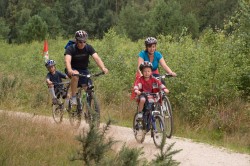 Background
BackgroundGreen spaces in and around towns and cities provide a wide range of goods and services, including offering sustainable travel options. For most people, especially the 80 per cent of people in England who live in urban areas, having local green space nearby is very important. As green corridors, green spaces are migration systems for people and wildlife, and these connect with larger green spaces to form a green space linkage or network.
The concept of transport networks seeks to recognise the importance of green space linkages as an essential component of a more sustainable urban environment, and improve the multi-functionality of these green networks through better management.
The development of green and water spaces for more active recreation and to facilitate pedestrian and cycle movement has great potential for extending their use. However, there is some evidence that the development plans in cities do not always explicitly utilise green space for transport links in urban areas where the opportunity is available.
The needs of different users and age groups and the consideration of safety issues can be accommodated at the design stage. With proper planning, and the creative and practical use of light, the usage of green public spaces can be extended well into the evening without the need for unnecessary barriers or perceived safety threats.
A number of sustainable travel schemes have been set up across the UK:
The national cycle network is made up of 12,600 miles of walking and cycling route across the UK. The network was founded by Sustrans in 1995 when the first route from Bristol to Bath was formed along a 17-mile long disused railway with the aim of providing traffic free paths as a route to get to work.
TfL and Sustrans have been funding shared cycling and walking schemes to and through parks or alongside watercourses over the past few years. The TfL Greenways programme invested £4 million in 2009/10, and it was predicted that this investment would deliver 100 schemes and add 18.3 km to the network by March 2010. However, budget restraints have reduced the amount of available funding for this scheme.
The aim of this programme is to support sustainable travel to the Olympics in 2012 and afterwards. The programme is made up of 150 schemes which will deliver improvements to accessibility, walking and cycling facilities along a total of eight routes in London. £9.8 million has been invested in the programme which is currently on target to have all eight routes implemented by the end of May 2011.
The aim of the Strategic Walk Network (SWN) is to improve walking conditions along seven walking routes across London. The SWN is a leisure-walking programme funded by TfL and implemented by the boroughs. The current funding contribution is £1.5 million per annum for the development and full delivery of the Network by 2012. The funding contributes to the implementation of a range of measures, including path surface improvements, improved accessibility, route signage, route mapping and promotional materials.
This bike scheme has been set up in London to encourage the use of cycling for short distance journeys and generate 40,000 extra cycle trips a day in central London to reduce car journeys, and ease congestion on public transport. This scheme benefits from the use of urban green space along many routes or greenways across the city.
The Cycle to Work scheme has also been implemented for a number of years now across the UK, to encourage employers to run the tax-free scheme for their employees. This scheme would also benefit from the use of urban transport networks across major cities in order to improve the accessibility to cyclists.
The Cambridge Green Infrastructure Strategy has been implemented with the vision to create and manage a comprehensive network of high quality and well–designed green corridors that:
The Clyde Waterfront Regeneration Initiative is recognised as a regeneration project of national importance and is the principal regeneration body within Glasgow and the surrounding area. One of the aims of this programme was to improve public transport, including better access to the river itself.
Forest Research are working in partnership with Scottish Natural Heritage (SNH), Glasgow and Clyde Valley Green Network Partnership (GCVGNP), and Forestry Commission Scotland (FCS) to explore approaches to planning Green Networks and People, which aims to support better integration of multi-functional green into spatial planning.
Mayor of London (2009) Better green and water spaces. The Mayor’s Great Spaces Design Support Programme.